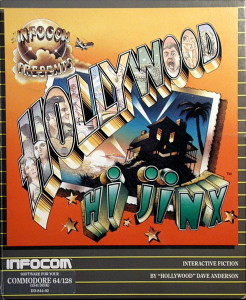Most happy offices, if they’re lucky, have one guy (or girl) who’s more important for the way he helps others enjoy coming to work than for the actual work he gets done personally when he’s there. He’s the guy who remembers birthdays and graduations; who organizes the softball team and the potlucks and the rotisserie baseball league and the NCAA basketball pools; who’s always willing to fetch lunch or (after working hours, hopefully!) a keg of beer; who’s always available for a meeting around the proverbial water cooler to laugh at a great new joke or commiserate with old disappointments. For Infocom, which for most of its lifetime was possessed of a very happy office indeed, that guy was “Hollywood” Dave Anderson.
A California boy through and through — one only had to hear his nickname or look at the loud beachwear he wore to work every day he could get away with it to divine that — Anderson had first come to Boston in late 1982 with his buddy Jeff O’Neill, executing a reverse Manifest Destiny to seek their promised land to the east. He was working in a sawmill a few months later when he saw an advertisement in the newspaper from a company he’d never heard of called Infocom, looking for game testers. He didn’t know much of anything about computer games, but getting paid to play them all day certainly sounded a lot better than life at the sawmill. He became one of Infocom’s first full-time testers, taking over from Steve Meretzky, who was already moving on up to write Planetfall. Soon O’Neill joined him in the same role. Hollywood was good at his job, thorough and insightful in everything from spotting typos to bigger questions of design and puzzle fairness. With the testing department growing rapidly around him in Infocom’s first bloom of major commercial success, within six months he was the old man of the group, officially given the title of Lead Playtester.
Something else that happened at nearly the same time does much to explain the even more important role that Anderson was already playing at Infocom. One day in November of 1983, he decided it was high time that somebody clean up the stagnant goldfish pond located outside Infocom’s Wheeler Street offices. He scooped out the three fish, moved them to a temporary holding tank, drained the pond and diligently scrubbed it clean, and put fresh water back in. Anyone who knows anything about fish — a group that apparently didn’t include Anderson or anyone else at Infocom whom he might have talked to about his scheme — can probably guess what happened when he put the fish back in the next day. They all promptly died, undone by a screwed-up pH balance or incorrect oxygen content or bad karma or whatever it is that makes domestic fish die if you so much as look at them wrong (one wonders how evolution ever spared this bunch). The others at Infocom decided to prosecute him for the fish’s murder, with Marc Blank acting as prosecutor, Steve Meretzky as his defense attorney, Mike Dornbrook as fishy expert witness, and nine upright Infocom employee/citizens as the jury. After a lengthy — okay, not really lengthy — trial, he was found not guilty, the victim of a frame job by the real murderer, a Micro Group programmer — and jury member to boot! — named Poh Lim. Lim was sentenced to life in the Graphics “Group,” a truly solitary confinement given the state of the company’s graphics technology at the time.
Hollywood’s trial passed into Infocom lore as one of the first grand comic absurdities of the sort that their staffers would raise to a high art. It also says much about his own role in daily life in the office, from the energetic helpfulness that led him to clean the pond so thoroughly in the first place to the gleeful way he jumped aboard to play his role in the whole (mis)carriage of justice. His name didn’t appear on the game boxes, but faithful readers of Infocom’s New Zork Times newsletter, if they were really paying attention, would have noticed that his name and sometimes picture crop up over and over in accounts of the cheerful insanity that was daily life at the company. He doesn’t hog the limelight — he wasn’t that kind of guy, not at all — but he’s always there, as a participant and as often as not an instigator.
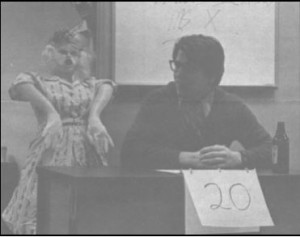
Hollywood doffs his trademark loud shirt for once to act as host of a live-action What’s My Line? show.
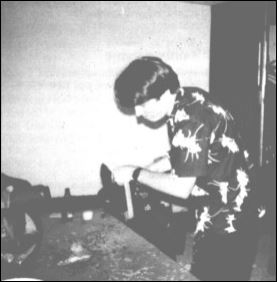
Back in his preferred attire, Hollywood carves a pumpkin with a chainsaw (!) at Infocom’s Halloween party. I guess the time at the sawmill did prove to be good for something after all.
It was for example Hollywood who, after seeing the noble sport at a lounge in his namesake city in California, brought hermit-crab racing to Infocom. Teams were established, and a prize collection of crabs bought by Hollywood at a local pet store auctioned off to each to carry its standard at Drink’em Downs raceway, constructed in the ample space left over inside the CambridgePark Drive offices after Cornerstone had come and gone.
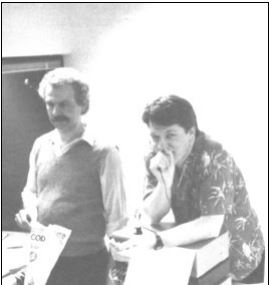
Drink’em Downs track announcer Hollywood calls the action, assisted by track timer Stu Galley. The latter had a difficult job: races could take a while, as the crabs had a tendency to say, “Screw this!” and shrink into their shells at the starting gate.
But Hollywood’s most legendary exploits took place on the softball field. He was instrumental in setting up Boston’s Software Softball League, which included along with Infocom the likes of Spinnaker and Lotus. Hollywood became the coach of Infocom’s team, making the official uniform, inevitably, a loud floral shirt. The games became a pivotal part of Infocom’s social calendar, a bonding experience notable even by the company’s usual close-knit standards. In trying to explain how it was at Infocom during the early years when everything they touched seemed to turn to gold, many old employees turn back to those sun-kissed summer days on the softball field when a ragtag bunch of them would show up with several coolers full of beer and little idea who was even playing what position to compete against companies often several times their size, companies that held actual practice sessions and even had actual uniforms — and, much more often than not, Infocom would win. That said, those chalking the wins purely up to Infocom’s charmed early life were doing something of a disservice to their best player. It seems safe to say that Hollywood all but won some games by himself, what with his eye-popping yearly batting averages of .800 or better and his habit of hitting home runs by the handful.
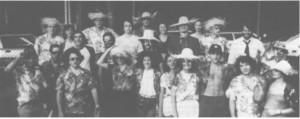
A motley crew but an effective one on the softball field. Of the guys wearing the ridiculous straw hats, Hollywood is the one to farthest left.
The story of Hollywood Anderson at Infocom is to everyone who was actually there and, indeed, to him as well largely the story of an all-around good mate, not of a game designer. This fact highlights a distinction that perhaps isn’t always appreciated enough, setting into stark relief just how differently Infocom was and is regarded by those who were inside the company in contrast to those who just loved the games. The company that people like me love to idealize as visionaries of interactive storytelling was for the people there first and foremost just a great social experience, for many or most the very best of their entire lives. To them Infocom was about computer games only secondarily. The Infocom that they knew is one that we cannot — and, what with them being so hopelessly close to the sausage-making that led to the games, the opposite is also true. When interviewed by Jason Scott for his Get Lamp documentary, Hollywood didn’t seem to want to talk about his one and only game Hollywood Hijinx so much as all the memories he has of Infocom as a place, memories that often deal only tangentially with the actual nuts and bolts of making interactive fiction.
Even taken on these terms, however, the story of Hollywood’s transformation from tester and life of the Infocom party to Implementor is an unusual one in comparison to that of his peers. Unlike Steve Meretzky or Jeff O’Neill, talented writers and frustrated artists who worked hard to get out of the testing department, and still less like Brian Moriarty, who accepted a job in the Micro Group with the secret agenda of becoming an Imp by hook or by crook, designing his own game just seemed to kind of fall into Hollywood’s lap. He was good at his job and took it seriously, but his passion for the medium didn’t exactly burn with the heat of a thousand suns. He himself notes that the staff was divided between those who believed they were on the cusp of a new form of interactive literature and those who saw their products as “just games.” He, no tortured-artist type by temperament or circumstance, saw them pretty definitively as the latter — the more game-like the better, in fact. Hollywood was an old-school guy who still held Zork up as a sort of gold standard. He was a member of the small minority of even old-school players who love mazes; he loved nothing more than to hunker down with a blank piece of graph paper and a full inventory to drop’em and map’em.
Of course, one would have to be a deeply incurious person to test interactive fiction as a full-time job for literally years without developing some interest in what went into making it. One year Infocom hired a high-school boy named Tom Bok to help with testing over the summer. He got hold of the ZIL source code to the original Zork and started playing around with it, first just by substituting text of his own but later by experimenting with the actual instructions. Both Hollywood and his old buddy Jeff O’Neill got interested in his explorations, and the trio made a spoof they called Zok — a portmanteau of Zork and Bok — that was widely played by others in the office.
Still, while those experiments led O’Neill in fairly short order to pitch and get accepted his idea for Ballyhoo, Hollywood’s own route to Imphood would be more circuitous. When Activision bought Infocom in mid-1986, one of Jim Levy’s first requests was that they start making more games — many more in fact, to the tune of twice as many releases per year as had been their wont. To meet that demand, they would need more Imps, and hard experience had taught them that hiring people off the street and expecting them to learn this absolutely unique art form didn’t usually work, even if they had the money in the budget for it (which they really didn’t). But right there was Hollywood, who’d been testing games for three years now and thus knew the form about as intimately as anyone who hadn’t actually written a game before could. And this was Hollywood, whom everyone liked and appreciated. Wouldn’t it be nice for him to see his name on a box? Hadn’t he earned that through his years of many and varied services? If the door wasn’t quite held wide for him, it was certainly somewhat ajar. All he really had to do was saunter through with a half-decent idea.
In a telling foreshadowing of how his game would end up being developed, even the initial idea wasn’t his. It was Liz Cyr-Jones, another tester who would be promoted to Hollywood’s old role of Lead Playtester upon his departure (how’s that for motivation?), who proposed making his game an extended homage to his long-standing nickname, so ingrained by now that The New Zork Times had taken to writing his name as “Dave” Hollywood Anderson. Hollywood Hijinx would be a scavenger hunt taking place on the mansion of your recently deceased Uncle Buddy and Aunt Hildegarde Burbank, B-movie moguls par excellence. According to the terms of their will, you need to find ten mementos from their movies in the course of a single night to inherit their fortune. It seemed a fun premise to Hollywood, perfectly suited to his own gaming predilections and experience — or, rather, his lack thereof. It was essentially a Zork set in the present day, the focus firmly on the puzzles that were to him the most interesting part of interactive fiction. The deserted, static grounds of the mansion would make the programming easier, while the played-for-laughs B-movie premise would let him liven them up with a bit of humor and atmosphere while being surreal enough that he didn’t need to worry too much about realism or plot or any of the rest of the stuff that Infocom’s preferred characterization of their games as “interactive fiction” normally implied. He pitched Jones’s idea, and, sure enough, it was accepted. Just like that, he was an Imp.
While it would bear Hollywood Anderson’s name on its cover and it would certainly be him who had final say on the project, Hollywood Hijinx is one of the two Infocom games since the days of the original Zork that is best described as a true group effort. (The other would be their very next game, subject of my next article. Its development would take that path, however, for very different reasons.) Just about everyone in the testing department pitched in with ideas for puzzles and gags, treating it as a welcome chance to make a game of their own for a change instead of only breaking the games of others. But Hollywood’s collaborators also extended far beyond the testing people. The only really big fan of B-movies at Infocom — Hollywood himself barely even knew who Roger Corman was — was, perhaps surprisingly, “Professor” Brian Moriarty, on the surface at least the most serious and “literary” of all the Imps. He pitched in with lots of ideas to lend humor and texture to the game, and took the time to write some of Tinsel World, the dishy showbiz magazine that became the centerpiece of the feelies. Infocom’s packaging people reveled in their freedom from overly stringent Imp guidance to come up with much of the rest from their own whole cloth. Hollywood did most of the programming himself, but admits to spending a lot of time “running around the office groveling” to Steve Meretzky or Dave Lebling to help him when it got beyond “the basics” of ZIL. None of this should be taken as a dismissal of Hollywood’s ability, and certainly not as an accusation of dishonesty. A social animal if ever there was one, this was just his natural way of working. And, good guy that he was, everyone was more than happy to help.
I wish I could tell you that the game that resulted from all of this is one of the Infocom greats, a tribute to Hollywood’s infinite good will and subtle leadership. Sadly, however, I can’t. There are worse games in the catalog than Hollywood Hijinx, but I’m not sure there are any that feel quite so inessential as this one. Indeed, it has to be the single least innovative Infocom game ever. Its most immediately striking feature, not least because you encounter it almost immediately, is the mansion’s defiantly old-school hedge maze, the single largest, gnarliest example of its type ever to appear in an Infocom game. (I did mention that Hollywood loved mazes, didn’t I?) Thankfully you can, after solving a number of other puzzles, put together an in-game map of the thing that will see you through in lieu of solving it yourself; one suspects that this must have been added by Hollywood under duress after hearing from outraged testers. Problem is, it’s all too easy to not realize that’s possible when you first encounter the maze, especially because the map is hidden behind some fairly tricky puzzles that you may not believe are solvable without discovering what’s in the maze’s center first. Remember this, would-be players, and don’t spend several hours mapping the thing — unless, like Hollywood, you enjoy that sort of thing — as I did when I first played!
Of course, innovation isn’t everything, and there’s certainly always room for a well-done Zork-like puzzlefest. Unfortunately, though, Hollywood Hijinx doesn’t quite hold up even on those terms. Most of the puzzles are fine, some (like one involving a certain delightful Godzilla-themed interactive diorama) more than fine. But there’s also one that’s notably terrible, arguably the worst single puzzle to appear in an Infocom game since the infamous baseball maze and bank in Zork II. Because I seem to have developed a regular sideline (or form of personal therapy) in complaining about puzzles, I’m going to describe (and spoil) it in the next paragraph. Sensitive readers may want to skip what follows.
So, you discover a water-filled channel through which you can swim to resurface in a cave complex. Being a cave, however, it has no light. You have a flashlight and also some matches that are theoretically capable of providing some, but the flashlight isn’t waterproof. The obvious thing would be to find a Ziploc bag or other waterproof container to put a light source into, but the mansion’s larder, alas, isn’t well-stocked with such practical necessities. The solution that you eventually discover — or, more likely, look up in the hint book or walkthrough — requires you to coat a match with wax from a burning candle, then scrape it off when you surface on the other end of the pool. That’s an iffy enough proposition in itself, but the game’s text for some reason decides to make it even harder to believe — and to solve. When you “put wax on match,” the response is that “the match head [emphasis mine] is now covered with a thin coating of candle wax.” We have here another of that thriving subspecies of text-adventure puzzles that just don’t make any practical sense whatsoever given the consensus version of reality we presumably share with the games we play. Even if the wax has miraculously kept the match head dry, and even if it’s possible to scrape off all of the glop and still have a strikeable head, all of the rest of the match — you know, the part that actually burns — is still all wet. That it couldn’t possibly burn seems so obvious that I spent a long time banging my head against other walls, sure this particular action couldn’t have anything to do with this particular puzzle. I even took the game’s choice of describing the wax as coating only the head as a deliberate kindness meant to steer me away from seeing it as a solution to the problem of a comprehensively wet match. Little did I know…
The writing in Hollywood Hijinx is mostly fine, enlivening its puzzles with fun props and memories hearkening back to the Burbanks’ glory days. As with so much in this game, it’s hard to say how many of the atmospheric touches were devised by Hollywood himself and how many were passed along to him by others, but then it’s not ultimately all that important anyway. For a guy who was more interested in puzzles than text, Hollywood, to his credit, managed to oversee an enjoyable reading as well as playing experience. The only really jarring moment comes when you screen a copy of Uncle Buddy’s lost film A Corpse Line, when the tone suddenly shifts from gentle satire to full-on zombie horror. I’m still not entirely sure if the disturbing scene you witness and the death you suffer immediately afterward are meant to be parodic and just come off wrong or if they really are meant to be horrific. Either way, they stand out from the rest of the game like, well, a dancing corpse in a top hat.
Much more problematic for anyone trying to solve Hollywood Hijinx are just a few places where the scene that Hollywood is evidently seeing in his mind’s eye isn’t quite captured in its entirety in the text, making, whether intentionally or unintentionally, some things harder than they would otherwise be. (The inside of the fireplace is the most notable offender; know that the “loose mortar” that the game so casually describes apparently isn’t so much loose as irregular, providing lots of convenient… well, I’m sure you can figure the rest out for yourself. The other possibility is that you’re an acrobat who’s capable of sticking one toe into a hole at waist height, stepping up, and balancing there on the face of an otherwise smooth — and loosely mortared to boot — wall.)
The little glitches that dog Hollywood Hijinx may have something to do with the unique collaborative process that was its making. If most of the testers are pitching in with ideas and puzzles, the obvious danger becomes that they get too close to the design, unable to see it anymore as an objective outsider would. In short, if the testers are writing the game, who’s testing it? (There may be an aphorism in there somewhere…) Yet it’s also true that this would hardly be the last time that cracks in Infocom’s usual smooth veneer of polish would be noticeable in their last great surge of text-only games of which Hollywood Hijinx is the first. I’ll take up the question of precisely why that should be at greater length in another article, but will just note for now that Infocom was suddenly being asked to become prolific on a scale which they had never approached before in their history. Between January 1987, the date of Hollywood Hijinx‘s release, and January 1988, when they would release their last all-text adventure game, no fewer than nine titles would pour out of their offices, a rate of production nearly twice that of any other twelve-month period in their history. The number of personnel involved in making the games, meanwhile, did not increase. In fact, just the opposite: Infocom hired their last employee in 1985. As people left in the months and years that followed, they were never replaced. Even when Hollywood stepped up to become an Imp the testing vacancy he left behind remained unfilled in perpetuity, leaving the company with one less conscientious tester to cover a flood of new games that threatened to drown the whole department. Looked at in this light, the biggest surprise is that Infocom’s games of 1987 didn’t suffer still more, that Infocom managed in spite of it all to turn out some final gems worthy of standing alongside anything from their less harried earlier years.
After Hollywood Hijinx hit the street and promptly became Infocom’s lowest seller to date, their first to fail to break even 20,000 copies, Hollywood Anderson evinced no particular burning desire to make another game. He rather parlayed his knowledge of Aldus PageMaker into his third and final role at Infocom. As their desktop-publishing expert, he helped to put together the newsletters that were still sent out every quarter to the remaining Infocom faithful. (Indeed, the newsletters seemed to grow in size and ambition almost in direct opposition to the dwindling sales of the actual games.) It was a perfect role for him. Even as the realities of life inside CambridgePark Drive grew ever more stressful, he continued to put a good face on it for the outside world, filling the newsletters with stories of the latest antics and coming up with delightfully goofy promotional ideas that could be used to drum up a little enthusiasm for very little of the money that Infocom increasingly didn’t have. The “take a picture of yourself holding an Infocom game on the Great Wall of China” contest, for example, became a particular favorite of fans and employees alike. Still, he remained as always most valuable not for what it said in his job description but for what he brought to daily life at the office. His peers during this last couple of years had more need than ever for his affable charm and unflappable sense of fun.
I’ve seen a few “where are they now?” pieces done on one-hit wonders of the music industry in which the subjects have noted how frustrating it can be to be perpetually framed with that negative label. After all, just getting one song played on the radio and bought in mass quantities by a fickle public — heck, just getting signed and getting a record out at all — is more than the vast majority of working musicians will ever achieve. Similarly, while his game is far from the best of the pack, Hollywood Dave Anderson is one of the vanishingly small number of people on the planet who can hold up an Infocom box with his name on the cover. That’s an achievement in itself. If the skids that got him there were just slightly greased in contrast to his peers, you’ll never meet a single one of them with a resentful word to say about it. Hollywood, because of who he was and what he brought to their lives every day, deserved his little twirl in the limelight. As long as the Infocom catalog is remembered, there will be his game — his name — nestled in there among the others, a reminder of a great chum and a place that was for six or so great years a great place to be young and creative and happy. There are certainly worse legacies to have.
(As usual with my Infocom articles, much of this one is drawn from the full Get Lamp interview archives which Jason Scott so kindly shared with me. Thanks again, Jason! Other sources include Infocom’s New Zork Times and Status Line newsletters of Spring 1984, Summer 1984, Summer 1985, Winter 1986, Fall 1986, Winter 1987, Summer 1987, Fall 1987, Winter 1987, Spring 1988, and Summer 1988, and Down From the Top of Its Game, an academic paper on the company’s history.)
